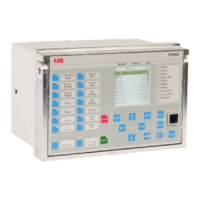Section 4 1MAC309294-MB F
Protection functions
90 RER620
Technical Manual
• Selective overcurrent and short-circuit protection of feeders in distribution and
subtransmission systems
• Backup overcurrent and short-circuit protection of power transformers and generators
• Overcurrent and short-circuit protection of various devices connected to the power
system, for example shunt capacitor banks, shunt reactors and motors
• General backup protection
51P/50P is used for single-phase, two-phase and three-phase non-directional overcurrent
and short-circuit protection. Typically, overcurrent protection is used for clearing two and
three-phase short circuits. Therefore, the user can choose how many phases, at minimum,
must have currents above the pickup level for the function to trip. When the number of
pickup-phase settings is set to “1 out of 3", the operation of 51P/50P is enabled with the
presence of high current in one-phase.
Many applications require several steps using different current pickup levels and time
delays. 51P/50P consists of three protection stages:
• Low 51P
• High 50P-1/2
• Instantaneous 50P-3.
51P is used for overcurrent protection. The function contains several types of time-delay
characteristics. 50P-1/2 and 50P-3 are used for fast clearance of very high overcurrent
situations.
Transformer and busbar overcurrent protection with reverse blocking
principle
By implementing a full set of overcurrent protection stages and blocking channels between
the protection stages of the incoming feeders, bus-tie and outgoing feeders, it is possible
to speed up the operation of overcurrent protection in the busbar and transformer LV-side
faults without impairing the selectivity. Also, the security degree of busbar protection is
increased, because there is now a dedicated, selective and fast busbar protection
functionality which is based on the blockable overcurrent protection principle. The
additional time selective stages on the transformer HV and LV-sides provide increased
security of backup protection for the transformer, busbar and also for the outgoing feeders.
Depending on the overcurrent stage in question, the selectivity of the scheme in Figure 11
is based on the operating current, operating time or blockings between successive
overcurrent stages. With blocking channels, the operating time of the protection can be
drastically shortened if compared to the simple time selective protection. In addition to the
busbar protection, this blocking principle is applicable for the protection of transformer
LV terminals and short lines. The functionality and performance of the proposed
overcurrent protections can be summarized as seen in the table.
When the setting is “2 out of 3" or “3 out of 3", single-phase faults are not
detected. The setting “3 out of 3" requires the fault to be present in all three
phases.

